2013 Peugeot 3008 Hybrid 4 warning
[x] Cancel search: warningPage 151 of 340
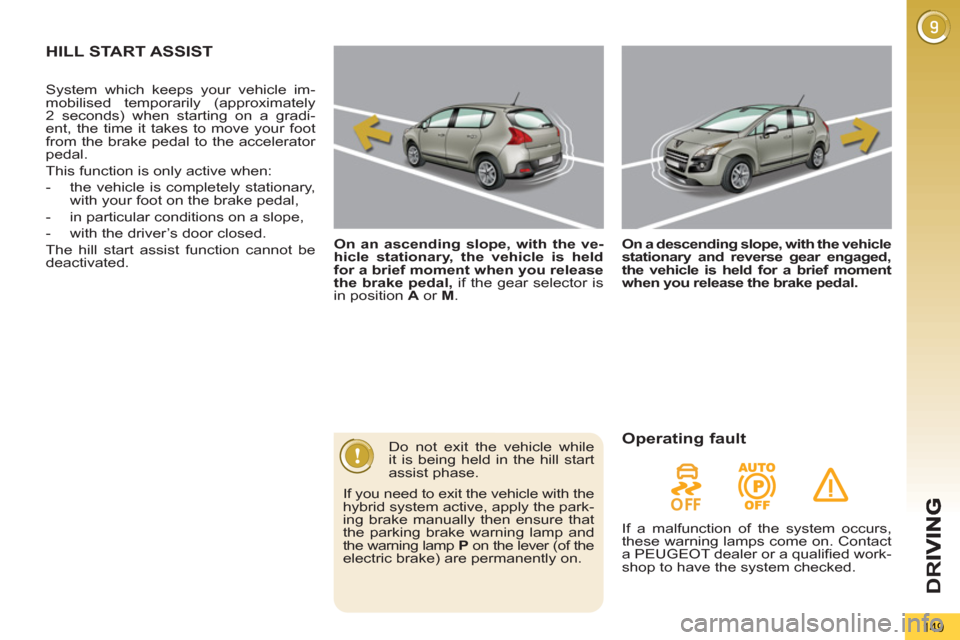
D
R
149
HILL START ASSIST
On an ascending slope, with the ve-
hicle stationary, the vehicle is held
for a brief moment when you release
the brake pedal,
if the gear selector is
in position A
or M
.
On a descending slope, with the vehicle
stationary and reverse gear engaged,
the vehicle is held for a brief moment
when you release the brake pedal.
Do not exit the vehicle while
it is being held in the hill start
assist phase.
If you need to exit the vehicle with the
hybrid system active, apply the park-
ing brake manually then ensure that
the parking brake warning lamp and
the warning lamp P
on the lever (of the
electric brake) are permanently on.
Operating fault
If a malfunction of the system occurs,
these warning lamps come on. Contact
a PEUGEOT dealer or a qualifi ed work-
shop to have the system checked.
System which keeps your vehicle im-
mobilised temporarily (approximately
2 seconds) when starting on a gradi-
ent, the time it takes to move your foot
from the brake pedal to the accelerator
pedal.
This function is only active when:
- the vehicle is completely stationary,
with your foot on the brake pedal,
- in particular conditions on a slope,
- with the driver’s door closed.
The hill start assist function cannot be
deactivated.
Page 152 of 340
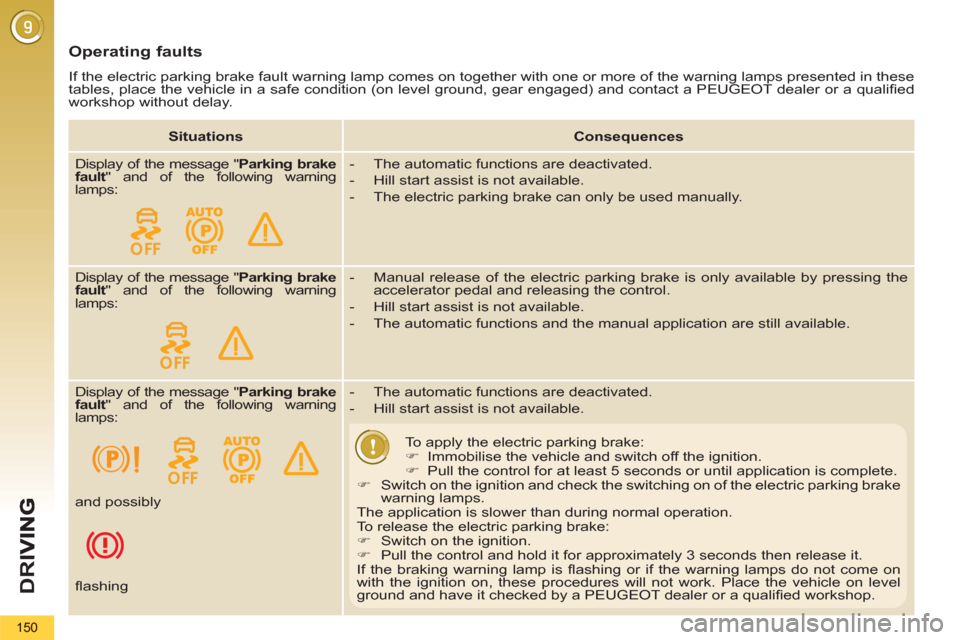
D
R
I
150
Operating faults
If the electric parking brake fault warning lamp comes on together with one or more of the warning lamps presented in these
tables, place the vehicle in a safe condition (on level ground, gear engaged) and contact a PEUGEOT dealer or a qualifi ed
workshop without delay.
Situations
Consequences
Display of the message " Parking brake
fault
" and of the following warning
lamps:
- The automatic functions are deactivated.
- Hill start assist is not available.
- The electric parking brake can only be used manually.
Display of the message " Parking brake
fault
" and of the following warning
lamps:
- Manual release of the electric parking brake is only available by pressing the
accelerator pedal and releasing the control.
- Hill start assist is not available.
- The automatic functions and the manual application are still available.
Display of the message " Parking brake
fault
" and of the following warning
lamps:
- The automatic functions are deactivated.
- Hill start assist is not available.
To apply the electric parking brake:
�)
Immobilise the vehicle and switch off the ignition.
�)
Pull the control for at least 5 seconds or until application is complete.
�)
Switch on the ignition and check the switching on of the electric parking brake
warning lamps.
The application is slower than during normal operation.
To release the electric parking brake:
�)
Switch on the ignition.
�)
Pull the control and hold it for approximately 3 seconds then release it.
If the braking warning lamp is fl ashing or if the warning lamps do not come on
with the ignition on, these procedures will not work. Place the vehicle on level
ground and have it checked by a PEUGEOT dealer or a qualifi ed workshop.
and possibly
fl ashing
Page 153 of 340
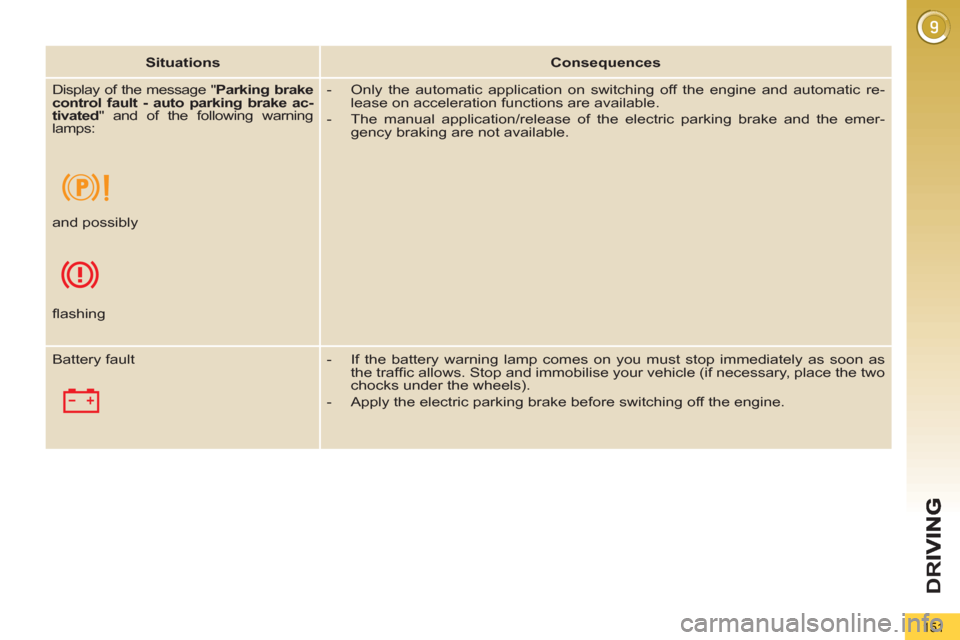
D
R
151
Situations
Consequences
Display of the message " Parking brake
control fault - auto parking brake ac-
tivated
" and of the following warning
lamps:
- Only the automatic application on switching off the engine and automatic re-
lease on acceleration functions are available.
- The manual application/release of the electric parking brake and the emer-
gency braking are not available.
and possibly
fl ashing
Battery fault
- If the battery warning lamp comes on you must stop immediately as soon as
the traffi c allows. Stop and immobilise your vehicle (if necessary, place the two
chocks under the wheels).
- Apply the electric parking brake before switching off the engine.
Page 161 of 340

D
R
159
Displays in the instrument panel
Gear selector positions
N.
Neutral
R.
Reverse
1, 2, 3, 4, 5, 6.
Gears in sequential mode
AUTO.
This comes on when the au-
tomatic mode is selected. It
switches off on changing to se-
quential mode.
Moving off
�)
Place your foot on the
brake
when this warning
lamp fl ashes (e.g.: when
starting the hybrid system).
�)
Select position N
.
�)
Select fi rst gear (position M
or A
) or
reverse (position R
).
�)
Take your foot off the brake pedal,
then accelerate.
�)
Release the parking brake unless it
is programmed to automatic mode.
AUTO
or R
appears in the in-
strument panel screen.
N
fl ashes in the instrument pan-
el, accompanied by an audible
signal and a message in the
multifunction screen, if the gear selec-
tor is not in position N
on starting.
Foot on brake
fl ashes in the instru-
ment panel, accompanied by an au-
dible signal and a message in the
multifunction screen, if the brake
pedal is not pressed on starting.
There is an audible signal when
reverse gear is engaged. N
appears in the instrument
panel screen.
Sequential mode
�)
When the vehicle has moved off, se-
lect position M
to change to sequen-
tial mode.
AUTO
disappears and the
gears engaged appear in suc-
cession in the instrument pan-
el screen.
The gear change requests are only car-
ried out if the engine speed permits.
It is not necessary to release the accel-
erator during gear changes.
When braking or slowing down, the
gearbox changes down automatically
so that the vehicle picks up in the right
gear.
At very low speed, if reverse
gear is requested, this will only
be taken into account when
the vehicle is immobilised. The Foot
on brake
warning lamp may fl ash on
the instrument panel to prompt you
to brake.
At high speed, if reverse gear is re-
quested, the N
indicator lamp will fl ash
and the gearbox will change to neutral
automatically. To engage a gear again,
return the selector to position A
or M
.
If you leave the vehicle, place
the gear selector in position N
and you must switch off the
hybrid system by switching off the ig-
nition ( Ready
lamp off).
�)
Press the brake pedal down fully.
�)
Start the hybrid system.
Page 165 of 340
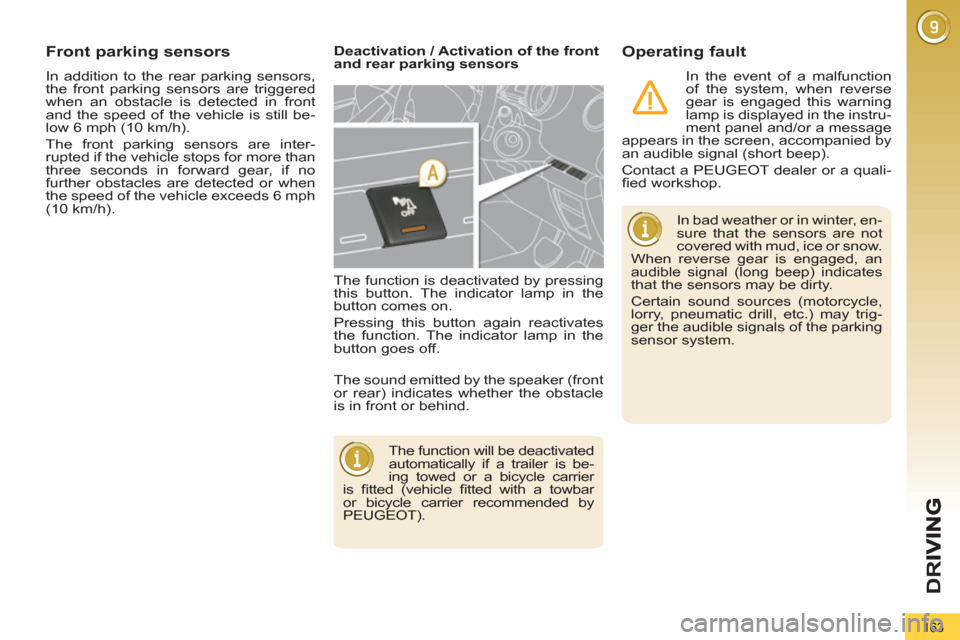
D
R
163
In addition to the rear parking sensors,
the front parking sensors are triggered
when an obstacle is detected in front
and the speed of the vehicle is still be-
low 6 mph (10 km/h).
The front parking sensors are inter-
rupted if the vehicle stops for more than
three seconds in forward gear, if no
further obstacles are detected or when
the speed of the vehicle exceeds 6 mph
(10 km/h).
Front parking sensors
Deactivation / Activation of the front
and rear parking sensors
The function is deactivated by pressing
this button. The indicator lamp in the
button comes on.
Pressing this button again reactivates
the function. The indicator lamp in the
button goes off.
Operating fault
The function will be deactivated
automatically if a trailer is be-
ing towed or a bicycle carrier
is fi tted (vehicle fi tted with a towbar
or bicycle carrier recommended by
PEUGEOT).
In bad weather or in winter, en-
sure that the sensors are not
covered with mud, ice or snow.
When reverse gear is engaged, an
audible signal (long beep) indicates
that the sensors may be dirty.
Certain sound sources (motorcycle,
lorry, pneumatic drill, etc.) may trig-
ger the audible signals of the parking
sensor system.
In the event of a malfunction
of the system, when reverse
gear is engaged this warning
lamp is displayed in the instru-
ment panel and/or a message
appears in the screen, accompanied by
an audible signal (short beep).
Contact a PEUGEOT dealer or a quali-
fi ed workshop.
The sound emitted by the speaker (front
or rear) indicates whether the obstacle
is in front or behind.
Page 171 of 340
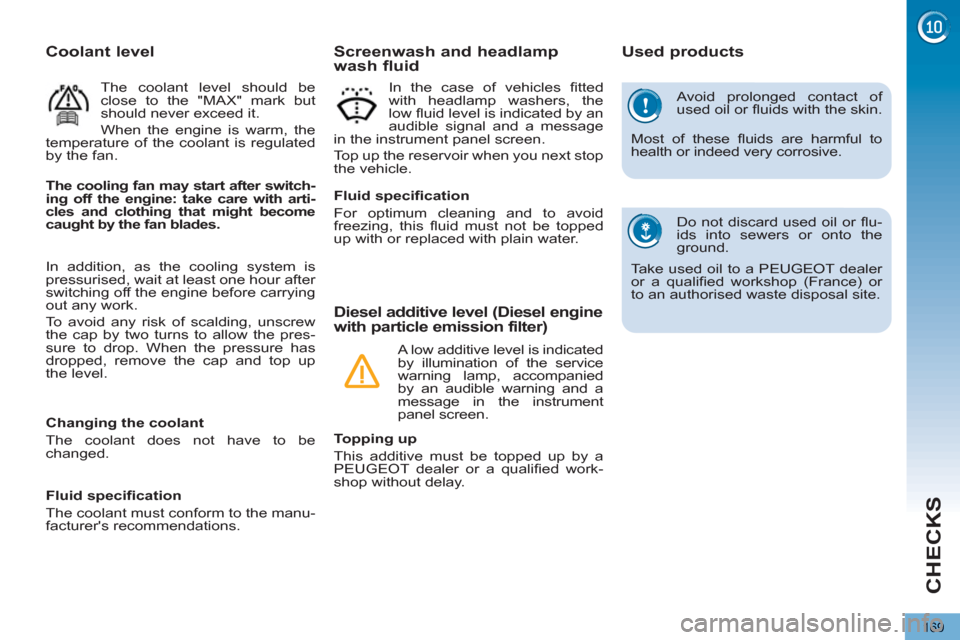
CHECKS
169
Avoid prolonged contact of
used oil or fl uids with the skin.
Most of these fl uids are harmful to
health or indeed very corrosive.
Do not discard used oil or fl u-
ids into sewers or onto the
ground.
Take used oil to a PEUGEOT dealer
or a qualifi ed workshop (France) or
to an authorised waste disposal site.
Diesel additive level (Diesel engine
with particle emission filter)
Used products
Topping up
This additive must be topped up by a
PEUGEOT dealer or a qualifi ed work-
shop without delay.
Fluid specifi cation
For optimum cleaning and to avoid
freezing, this fl uid must not be topped
up with or replaced with plain water.
A low additive level is indicated
by illumination of the service
warning lamp, accompanied
by an audible warning and a
message in the instrument
panel screen.
Screenwash and headlamp
wash fluid
In the case of vehicles fi tted
with headlamp washers, the
low fl uid level is indicated by an
audible signal and a message
in the instrument panel screen.
Top up the reservoir when you next stop
the vehicle.
Coolant level
The coolant level should be
close to the "MAX" mark but
should never exceed it.
When the engine is warm, the
temperature of the coolant is regulated
by the fan.
Changing the coolant
The coolant does not have to be
changed.
Fluid specifi cation
The coolant must conform to the manu-
facturer's recommendations.
The cooling fan may start after switch-
ing off the engine: take care with arti-
cles and clothing that might become
caught by the fan blades.
In addition, as the cooling system is
pressurised, wait at least one hour after
switching off the engine before carrying
out any work.
To avoid any risk of scalding, unscrew
the cap by two turns to allow the pres-
sure to drop. When the pressure has
dropped, remove the cap and top up
the level.
Page 172 of 340
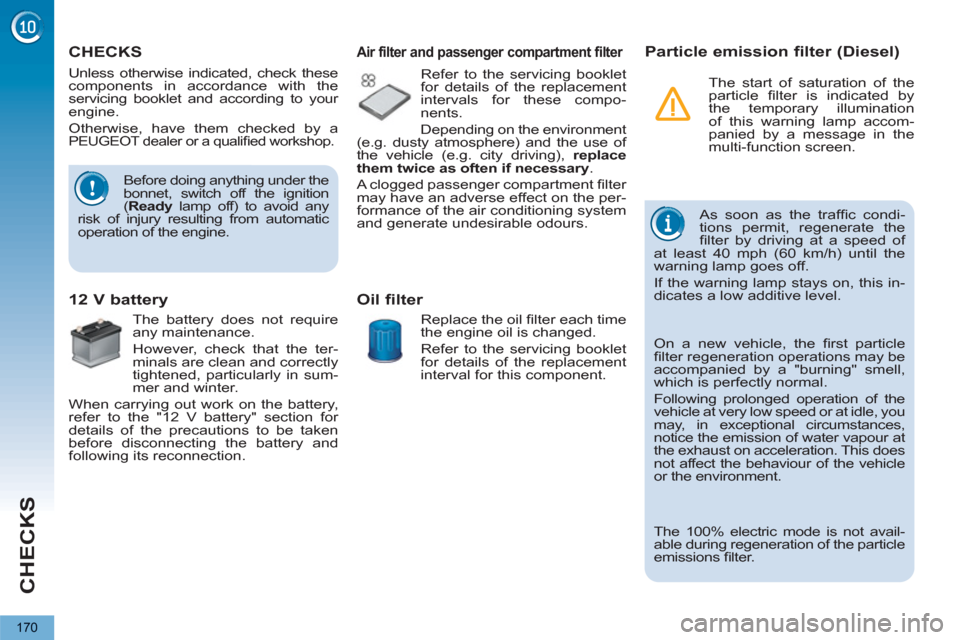
CHECKS
170
CHECKS
Before doing anything under the
bonnet, switch off the ignition
( Ready
lamp off) to avoid any
risk of injury resulting from automatic
operation of the engine.
Unless otherwise indicated, check these
components in accordance with the
servicing booklet and according to your
engine.
Otherwise, have them checked by a
PEUGEOT dealer or a qualifi ed workshop.
The battery does not require
any maintenance.
However, check that the ter-
minals are clean and correctly
tightened, particularly in sum-
mer and winter.
When carrying out work on the battery,
refer to the "12 V battery" section for
details of the precautions to be taken
before disconnecting the battery and
following its reconnection.
12 V battery
Air filter and passenger compartment filter
Refer to the servicing booklet
for details of the replacement
intervals for these compo-
nents.
Depending on the environment
(e.g. dusty atmosphere) and the use of
the vehicle (e.g. city driving), replace
them twice as often if necessary
.
A clogged passenger compartment fi lter
may have an adverse effect on the per-
formance of the air conditioning system
and generate undesirable odours.
Oil filter
Replace the oil fi lter each time
the engine oil is changed.
Refer to the servicing booklet
for details of the replacement
interval for this component.
Particle emission filter (Diesel)
As soon as the traffi c condi-
tions permit, regenerate the
fi lter by driving at a speed of
at least 40 mph (60 km/h) until the
warning lamp goes off.
If the warning lamp stays on, this in-
dicates a low additive level.
The 100% electric mode is not avail-
able during regeneration of the particle
emissions fi lter. The start of saturation of the
particle fi lter is indicated by
the temporary illumination
of this warning lamp accom-
panied by a message in the
multi-function screen.
On a new vehicle, the fi rst particle
fi lter regeneration operations may be
accompanied by a "burning" smell,
which is perfectly normal.
Following prolonged operation of the
vehicle at very low speed or at idle, you
may, in exceptional circumstances,
notice the emission of water vapour at
the exhaust on acceleration. This does
not affect the behaviour of the vehicle
or the environment.
Page 181 of 340
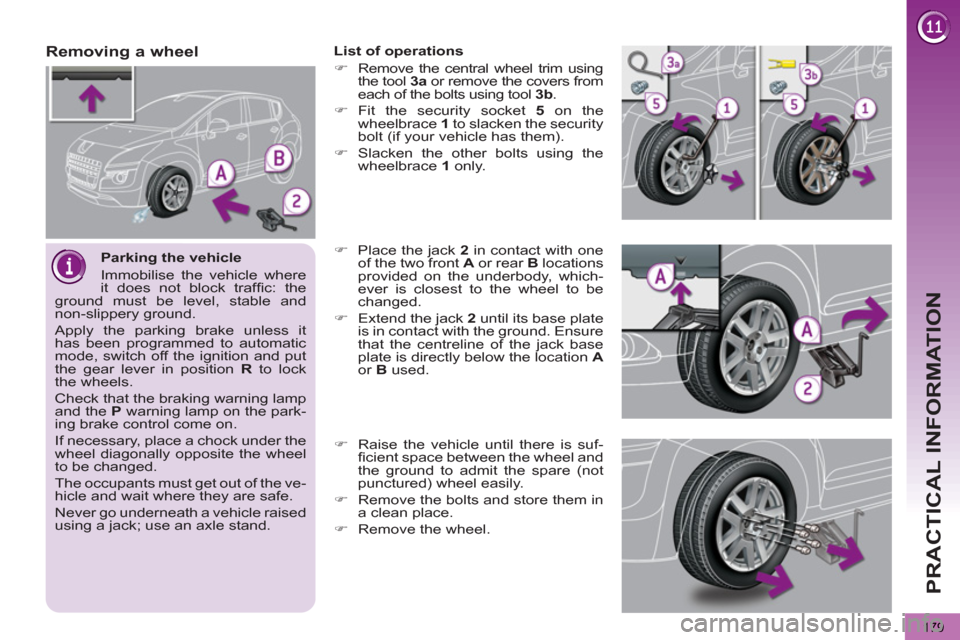
PRACTICAL INFORMATION
179
Parking the vehicle
Immobilise the vehicle where
it does not block traffi c: the
ground must be level, stable and
non-slippery ground.
Apply the parking brake unless it
has been programmed to automatic
mode, switch off the ignition and put
the gear lever in position R
to lock
the wheels.
Check that the braking warning lamp
and the P
warning lamp on the park-
ing brake control come on.
If necessary, place a chock under the
wheel diagonally opposite the wheel
to be changed.
The occupants must get out of the ve-
hicle and wait where they are safe.
Never go underneath a vehicle raised
using a jack; use an axle stand.
Removing a wheel
List of operations
�)
Remove the central wheel trim using
the tool 3a
or remove the covers from
each of the bolts using tool 3b
.
�)
Fit the security socket 5
on the
wheelbrace 1
to slacken the security
bolt (if your vehicle has them).
�)
Slacken the other bolts using the
wheelbrace 1
only.
�)
Place the jack 2
in contact with one
of the two front A
or rear B
locations
provided on the underbody, which-
ever is closest to the wheel to be
changed.
�)
Extend the jack 2
until its base plate
is in contact with the ground. Ensure
that the centreline of the jack base
plate is directly below the location A
or B
used.
�)
Raise the vehicle until there is suf-
fi cient space between the wheel and
the ground to admit the spare (not
punctured) wheel easily.
�)
Remove the bolts and store them in
a clean place.
�)
Remove the wheel.